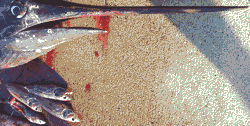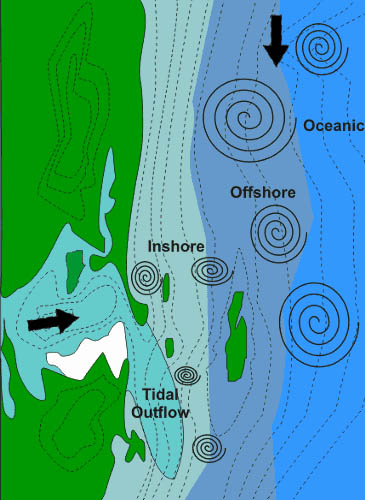03: Bait Profiles
Between The Lines - Ch 01: Profiles
The next step in understanding the system is considering differences in bait species that are generally found in the different zones as depth, colour and quality of water is reflected in the species that inhabit them.
Think about the common bait species that you know of in the inshore bays and harbours. There are far more than just the bait species commonly bought in your local tackle shop. In fact just about everything that swims or crawls is some other species food, or often food for others of the same species. However, the species that we are most interested in are those that school into shoals of others of the same species.
 |
 |
 |
|
|||
| Herring | Mullet | Tailor (Bluefish) | Yakka | Bonito | Slimy | Striped Tuna |
Consider the shape of these species, you’ll find that they are quite stubby and bulky with rather large often wide fins.
Such as the juvenile fish or Herringshape and the Mullet shape is also quite representative of shapes in this area. As we move into the inshore area many of the bait species from inside the bays are also found here, but many of the species are a bit more streamlined and narrower such as the Tailor. Many parts of the globe have very similar species known by other names, however, for this exercise, it is only the fish's physical look and behaviour that are of concern.
Some of the species have quite a large range that includes the estuaries, inshore and offshore grounds. These do however generally fit into the zones furthest away from the shore such as the Yakka which is found in all areas out to the offshore grounds and has close cousins that roam far offshore.
Consider the species we have looked at so far. They are not very streamlined. The colours are quite dull, often olive, brown or muddy blue backs with cream bellies, many are pure chrome with quite large scales. Most have yellow tinges to their fins and eyes which are also quite large for their size. They have very defined lateral lines.

 Although these fish are considered bait they often grow to quite large sizes. Many predators can easily swallow other fish 20% of their own size!!! More appropriate to our understanding is that most predators stomach contents show bait species much smaller than you’d imagine they’d bother eating.The markings are more defined and extend deeper on the sides towards the belly. Many of this zones species have mottled stripes and spots on their sides and stomachs. The shape gets more streamlined, the fins smaller in proportion to the size of the fish. The skin is also brighter, often displaying a shiny bright fluorescent quality. If the fish have scales, they are smaller than the species found closer to shore. The difference in colour between the backs and stomachs is quite high in contrast, certainly darker than the ones we have looked at so far.
Although these fish are considered bait they often grow to quite large sizes. Many predators can easily swallow other fish 20% of their own size!!! More appropriate to our understanding is that most predators stomach contents show bait species much smaller than you’d imagine they’d bother eating.The markings are more defined and extend deeper on the sides towards the belly. Many of this zones species have mottled stripes and spots on their sides and stomachs. The shape gets more streamlined, the fins smaller in proportion to the size of the fish. The skin is also brighter, often displaying a shiny bright fluorescent quality. If the fish have scales, they are smaller than the species found closer to shore. The difference in colour between the backs and stomachs is quite high in contrast, certainly darker than the ones we have looked at so far.
It is also interesting to note that species such as As we move into the Offshore zone we note that the species begin to have different attributes such as the Bonito. The markings are more defined and extend deeper on the sides towards the belly. Many of this zones species have mottled stripes and spots on their sides and stomachs. The shape gets more streamlined, the fins smaller in proportion to the size of the fish. The skin is also brighter, often displaying a shiny bright fluorescent quality. If the fish have scales, they are smaller than the species found closer to shore. The difference in colour between the backs and stomachs is quite high in contrast, certainly darker than the ones we have looked at so far.As we move towards the Oceanic zone the species become more streamlined, their fins smaller relative to the size of their bodies, their colours higher in contrast with very dark backs and silvery bellies, many with distinctive stripes such as the Slimy.
with its fluorescent striped sides and very dark blue-purple back. the Slimy have a large distribution across the zones. When they are in closer to shore their colour is more light green and when offshore a darker green to navy. Perhaps the bait species that best represents the offshore bait species is the Striped Tuna
In each of the different zones, there are many more species than mentioned here. Take some time and have a look at the different species that pass through the areas you fish. Are they built for speed and stamina? Do their large eyes indicate that they are nocturnal? Do they form small or massive schools? When they are feeding or being fed on do they hit the surface with large splashes or are they more subtle?
The things that are apparent is that the inshore species are stubbier, duller and slower than those further offshore. This has many connotations. Are the lures you’d choose the same in each zone, or do you have a little more to work with?
As the currents and eddies flow down the coast they move in and out over quite some distance. Often the Oceanic waters move in right along the shoreline bringing their bait species with them. A sign of this is observing streamlined, high contrast striped bait species in these areas and often the associated predators are right there with them.






